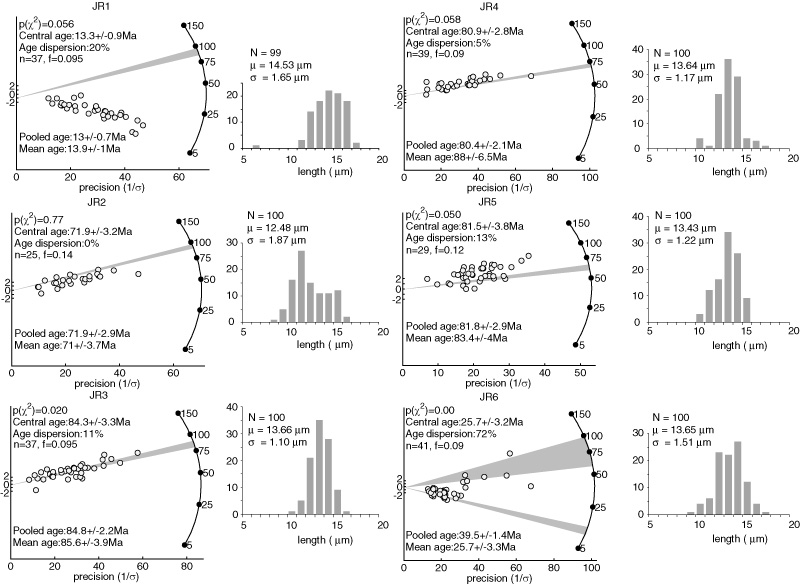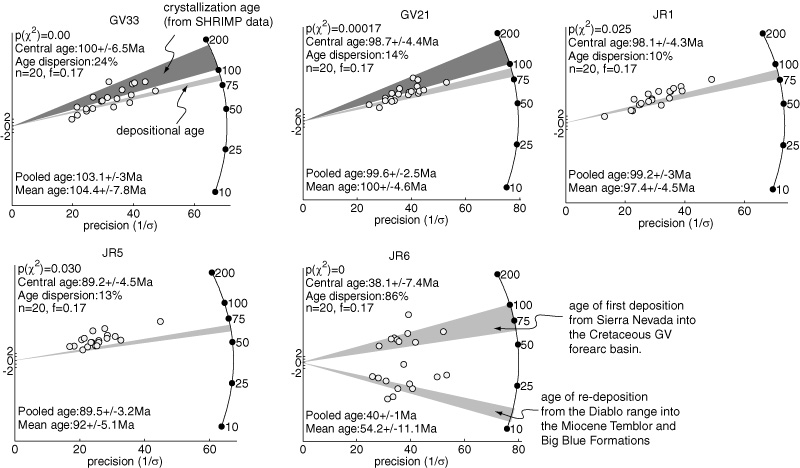Apatite fission tracks are immediately annealed at temperatures
![]() 110
110![]() C (e.g., Wagner and Van den Haute, 1992). At
temperatures less than about 60
C (e.g., Wagner and Van den Haute, 1992). At
temperatures less than about 60![]() C, apatite fission tracks are
completely preserved. The temperature zone between
C, apatite fission tracks are
completely preserved. The temperature zone between ![]() 60 and
60 and
![]() 110
110![]() C is named the apatite fission track partial
annealing zone (e.g., Dumitru, 2000). In this zone, fission tracks
are not immediately annealed, but gradually shortened with time. The
annealing temperature of zircon fission tracks is more controversial,
but generally considered to lie between 230 and 310
C is named the apatite fission track partial
annealing zone (e.g., Dumitru, 2000). In this zone, fission tracks
are not immediately annealed, but gradually shortened with time. The
annealing temperature of zircon fission tracks is more controversial,
but generally considered to lie between 230 and 310![]() C (see
discussion by Tagami and Dumitru, 1996). In this paper, we will assume
the more ``conservative'' value of
C (see
discussion by Tagami and Dumitru, 1996). In this paper, we will assume
the more ``conservative'' value of ![]() 230
230![]() C.
C.

|
First, we will discuss the apatite fission track data (Figure
2). Of the five Great Valley Group samples, four have
exclusively Cretaceous apatite fission track grain-ages, indicating
that these grains never reached temperatures greater than 110![]() C
since their deposition in the Great Valley Group. However, sample JR2
has the oldest depositional age of these four samples but the youngest
fission track ages, with the latter being even slightly younger than
the former. Therefore, JR2 has been partially reset, and saw
temperatures less than
C
since their deposition in the Great Valley Group. However, sample JR2
has the oldest depositional age of these four samples but the youngest
fission track ages, with the latter being even slightly younger than
the former. Therefore, JR2 has been partially reset, and saw
temperatures less than ![]() 110
110![]() C, but well above
C, but well above ![]() 60
60![]() C.
The fission tracks of sample JR2 are also significantly shorter than
those of the other samples, an additional suggestion that JR2 must
have been heated to well within the partial annealing zone. Sample
JR1, located the nearest to the New Idria serpentite, has completely
annealed apatite fission tracks and, therefore, was heated above
C.
The fission tracks of sample JR2 are also significantly shorter than
those of the other samples, an additional suggestion that JR2 must
have been heated to well within the partial annealing zone. Sample
JR1, located the nearest to the New Idria serpentite, has completely
annealed apatite fission tracks and, therefore, was heated above
![]() 110
110![]() C. It dates the end of the heating event at
C. It dates the end of the heating event at ![]() 14
Ma. Sample JR6 from the Miocene Temblor Formation contains two age
components: one Cretaceous and one Miocene component (Table
2). There also is a hint of bimodality in the fission
track length distribution. A first group of relatively short
(
14
Ma. Sample JR6 from the Miocene Temblor Formation contains two age
components: one Cretaceous and one Miocene component (Table
2). There also is a hint of bimodality in the fission
track length distribution. A first group of relatively short
(![]() 9-13
9-13 ![]() m) fission tracks formed prior to the mid-Miocene.
These tracks preserve Sierran provenance ages but were partially
annealed during the mid-Miocene thermal event. A second group of long
fission tracks (
m) fission tracks formed prior to the mid-Miocene.
These tracks preserve Sierran provenance ages but were partially
annealed during the mid-Miocene thermal event. A second group of long
fission tracks (![]() 13-17
13-17 ![]() m) formed after this thermal event,
and have not been annealed since then. Paleocurrent directions in the
Temblor and Big Blue Formations are west-to-east, which is the
opposite flow direction as for the Great Valley Group (Casey and
Dickinson, 1976; Bate, 1985; Bent, 1985). Therefore, the apatite
grains of the Temblor Formation have been redeposited from the
underlying Great Valley Group, some of which was thermally annealed
during a mid-Miocene thermal event.
m) formed after this thermal event,
and have not been annealed since then. Paleocurrent directions in the
Temblor and Big Blue Formations are west-to-east, which is the
opposite flow direction as for the Great Valley Group (Casey and
Dickinson, 1976; Bate, 1985; Bent, 1985). Therefore, the apatite
grains of the Temblor Formation have been redeposited from the
underlying Great Valley Group, some of which was thermally annealed
during a mid-Miocene thermal event.

|
The zircon fission track ages for four of the five samples are older
than the age of Great Valley Group deposition (Figure
3). Sample JR1, which had completely annealed apatite
fission tracks, also has unreset zircon fission track ages.
Therefore, sample JR1 was heated to more than ![]() 110
110![]() C, but less
than
C, but less
than ![]() 230
230![]() C after its deposition. The lag between
crystallization, exhumation and deposition times were short, which
means that the source area of these sediments exhumed rapidly. The
most surprising observation is that the Middle Miocene sample JR6,
which had a bimodal apatite fission track age distribution, also has a
bimodal zircon fission track distribution. The oldest mode of Mesozoic
ages is compatible with the unreset fission track ages of the Joaquin
Ridge samples located away from the serpentinite body (Table
1). The youngest age peak is concordant with the
C after its deposition. The lag between
crystallization, exhumation and deposition times were short, which
means that the source area of these sediments exhumed rapidly. The
most surprising observation is that the Middle Miocene sample JR6,
which had a bimodal apatite fission track age distribution, also has a
bimodal zircon fission track distribution. The oldest mode of Mesozoic
ages is compatible with the unreset fission track ages of the Joaquin
Ridge samples located away from the serpentinite body (Table
1). The youngest age peak is concordant with the
![]() 14 Ma apatite fission track age of sample JR1, and with the
youngest mode of the apatite fission track age distribution of JR6.
Because not all the apatite grains in JR6 were reset at
14 Ma apatite fission track age of sample JR1, and with the
youngest mode of the apatite fission track age distribution of JR6.
Because not all the apatite grains in JR6 were reset at ![]() 14 Ma,
we know that this sample was not heated to more than
14 Ma,
we know that this sample was not heated to more than ![]() 110
110![]() C.
In fact, there is ample evidence that the Temblor formation did not
see temperatures higher than
C.
In fact, there is ample evidence that the Temblor formation did not
see temperatures higher than ![]() 56
56![]() C east of Joaquin Ridge (see
below). Therefore, the
C east of Joaquin Ridge (see
below). Therefore, the ![]() 14 Ma old zircons must have been been
annealed prior to deposition in the Temblor and Big Blue formations.
Recalling the eastward paleocurrents of these deposits, this indicates
that at least part of the provenance area for the Temblor Formation,
which is Joaquin Ridge, reached temperatures as high as
14 Ma old zircons must have been been
annealed prior to deposition in the Temblor and Big Blue formations.
Recalling the eastward paleocurrents of these deposits, this indicates
that at least part of the provenance area for the Temblor Formation,
which is Joaquin Ridge, reached temperatures as high as
![]() 230
230![]() C as recently as
C as recently as ![]() 14 Ma.
14 Ma.